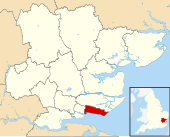 Southend Pier in 2007 | |
| Type | Pleasure, RNLI lifeboat station |
|---|---|
| Carries | Pedestrians, shuttle train, lifeboat crews/supplies |
| Spans | Thames Estuary |
| Locale | Essex, UK |
| Owner | Southend-on-Sea City Council[1] |
| Maintained by | Southend-on-Sea City Council |
| Characteristics | |
| Construction | Hardwood decking on iron piles |
| Total length | 2,158 metres (7,080 ft) |
| History | |
| Designer | James Brunlees |
| Opening date | 1830 (Iron pier, 1889) |
| Coordinates | TQ884849 (shoreside) TQ897830 (pierhead) |
 Southend-on-Sea district map | |
| Southend Pier Act 1829 | |
|---|---|
| Act of Parliament | |
 | |
| Citation | 10 Geo. 4. c. xlix |
| Dates | |
| Royal assent | 14 May 1829 |
| Other legislation | |
| Repealed by | Essex Act 1987 |
Status: Repealed | |
| Text of statute as originally enacted | |
Southend Pier is a major landmark in Southend-on-Sea, Essex, United Kingdom. Extending 1.33 miles (2.14 km) into the Thames Estuary, it is the longest pleasure pier in the world.[2] The bill to build the new pier, to replace a previous timber jetty, received royal assent as the Southend Pier Act 1829 (10 Geo. 4. c. xlix) in May 1829 with construction starting in July 1829. The timber pier was replaced by an iron pier that opened to the public in August 1889. The Southend Pier Railway, opened in the early 1890s, was the first pier railway in the country.
The pier played a role through both of the world wars, such as during World War I when ships housing German prisoners of war were moored off the pierhead. In the Second World War, the pier was taken over by the Royal Navy and was renamed HMS Leigh, closing to the public in September 1939. Following the war, around six million people visited the pier in 1949, exceeding pre-war visitor numbers, with new attractions opening during the 1950s. A period of decline began during the 1970s, with structural deterioration that led the council to announce closure plans in 1980. Following protests, the pier remained open and a grant in 1983 allowed renovation work to take place, including for a new pier railway that was opened in May 1986 by Princess Anne.
The pier has experienced several fires, notably in 1959, 1976, 1995 and 2005. The fire in 1976 was followed by another a year later, during a period when the pier was already in decline and resulted in the closure of the railway. In 1995, the fire caused significant damage requiring reconstruction of the deck. Just ten years later in 2005, another fire destroyed much of the wooden planking and caused significant damage to the old pierhead and surrounding structures.
Sir John Betjeman, English poet and broadcaster, once said that "the Pier is Southend, Southend is the Pier".[3] The pier is a Grade II listed building.[4]
- ^ "Southend Pier". National Piers Society. 27 March 2016. Retrieved 13 July 2021.
- ^ "Southend Pier". Southend Pier. Retrieved 16 August 2024.
- ^ "Architectural Heritage". BBC. Retrieved 21 August 2020.
- ^ "Pleasure Pier, Non Civil Parish - 1112705". historicengland.org.uk. Retrieved 17 May 2022.